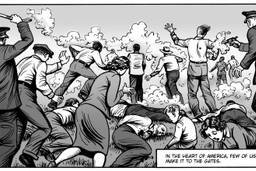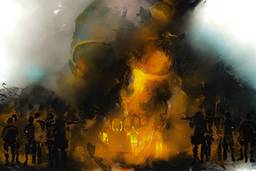
Kim Stanley Robinson is that rarest phenomenon of fiction, the keen stylist who understands at once hard science, global politics and the wide sweep of history. A Ph.D. in English and the most insightful critic-scholar of science-fiction giant Philip K. Dick, Robinson abandoned an academic career to write fiction. His non-sci-fi volumes have been varied and fascinating—from The Novels of P.K. Dick to an ecological trilogy about California—and most of them based on first-hand knowledge as well as close study. But it is his science fiction, especially his Mars books (Red Mars, Green Mars, Blue Mars and The Martians) that have won Robinson wide and evidently lasting fame.
No science-fiction author since Dick and Ursula Le Guin has seen so clearly the dilemmas that the corporate-military system, feeding upon war and environmental plunder, has prepared for civilizations near and far. All three authors, interestingly, happened to be from a futurist-oriented California: the older two raised in Berkeley or thereabouts, Robinson in Orange County. But where Dick stresses the psychological, and Le Guin (the daughter of famed anthropologist Alfred Kroeber) the anthropological, Robinson is a master of hard science, especially geology. Readers indifferent toward politics and those inclined rightward nevertheless thrill to Robinson’s close descriptions of what changes in the land have been wrought by the ages—and may be wrought in the future through “terraforming” the landscape and climate of barren planets.
In the Mars series, plunder is the real corporate agenda for colonization, along with the overpriced hope of somehow saving an ecologically devastated and desperately overcrowded planet Earth. Most of the space voyagers, chosen for their scientific credentials, shun the corporate agenda. But as they devise areas for colonization, they divide sharply over agendas “green” (turning Mars into a giant garden) or “red” (preserving most of its natural landscape). Eventually, however, the corporate threat leads to mass revolts among reds and greens alike, and the establishment of secret cooperative (and deeply feminist) outposts—all of which are met with repression.
————–
Here and there, often indirectly, Robinson has also sought to come to grips with religious passion in all its varieties. The Years of Rice and Salt, his new book, deals more directly with religion, and more directly with earthly religions, than his earlier works do, and for a very good reason: This is not about the future but an alternative past, where spirituality remains nonetheless familiar.
Well, not exactly familiar to all of us. Robinson has proposed a decisive shift in world history: The plague that wiped out huge swaths of European populations in the High Middle Ages went on to succeed in wiping out just about all white folks. Christendom has been reduced to a trace, practically a folk memory in other cultures. In what was never known as North and South America, the genocide of the native inhabitants never took place. Neither was there Hitler, nor Stalin, nor Truman; no Henry Kissinger, no Ariel Sharon and no George W. Bush—now there’s a series of happy thoughts! But also no Beethoven, no Elvis, no Brecht, no Katharine Hepburn and definitely no Homer Simpson.
But empires aplenty preceded the rise of Europe’s global outreach, and as Robinson sees it, they surely would have made up for Europe’s absence. Commercial expansion and the expropriation and exploitation of native dwellers, armored with the religious and pseudo-ethical rationalization always required for looting and slaughter, simply takes different paths.
Robinson wrote The Years of Rice and Salt before 9/11, but his central choice of Islam seems unerring in retrospect. Since Europe is empty (aside, naturally, from its plants and animals, of which we hear rather too little in this volume), Islam naturally expands westward. Meanwhile, the Chinese hold onto their large and deeply bureaucratic regional empire, the Aztecs or some version of them continue a regional consolidation, and Native North Americans gather enough knowledge to slow the expansions from various directions and grow their own commonwealth. Not greatly elaborated upon, this last is definitely the most matrilineal society, and the most egalitarian.
Islam gets the most attention for a very good reason, although Robinson doesn’t quite say so. Contrary to the Fox Network and just about every politician in Washington, premodern Islamic society looks a great deal like its premodern Christian counterpart. The bonding of various Islamic factions, continually warring against each other, rests in their common Arabic language and culture—much as the warring Christian nations bonded (and still bond) with their own claims of blood and culture.
So the Islamists increasingly search out natural resources and potentially servile populations, reach limits at points of successful resistance, enjoy their own Renaissance (with inevitable praise to Allah), and evolve in new ways thanks to the inevitable mixture and overlap of civilizations. By way of contrast, Robinson offers us mainly the Chinese, indifferent to Western theism, but scarcely less locked in assorted contradictions of class and gender.
These varied civilizations have a rich inner life of the kind that old-fashioned, presidents-and-generals history ignores. That inner life constitutes the experience of most of Robinson’s diverse cast of characters. As he neatly redraws regional maps for our closer understanding of the big picture, he posits reincarnation as a way of establishing links of consciousness across centuries.
It’s an odd stroke, but it sets up one element of the crucial final third of this large and complex novel. If passage through the “bardo,” the waiting room between reincarnations, is both necessary and painful (because so little progress is possible in a lifetime, and because most lives are contorted by the unhappiness of the world), then what Marx called “prehistory” can be seen as one long bardo, a collective awaiting. An elderly, interracial married couple, after a lifetime of scholarship sharing knowledge of their respective cultures—Chinese and Arabic—arrives at this philosophical conclusion more or less together. Afterward, the consciousness of more scientific knowledge, and intelligent caution at the use of scientific knowledge, occupy greater narrative space.
————–
If in this counter-history there was no Marx or Engels, and no Bakunin or Proudhon, what about the history of communist, socialist or anarchist movements and ideas? Robinson offers neither direct parallel nor outright contrast with European revolutions. Among the Muslims, a sort of Liberation Theology emerges intermittently, out of the sense that the true values of the religion have been corrupted but may be restored. What can be called a socialist-feminist society at the periphery rebels and governs itself for a while, until reconquered. Feminism, even if not called that, mightily takes center-stage in the final chapters, not at all accidentally as society acquires sufficient scientific knowledge to exterminate itself. In a scene that could have been written for today’s Venezuela, a popular movement with the poor and working women at the center successfully halts a military coup. Then, after a brief celebration, its members go back to work.
Ultimately, what thoughtful socialists used to call a “religion of humanity” comes to be seen as the proper, modern successor to the bardo. Collective experience (what we historians like to call social history, but now grown self-conscious) is the real reincarnation. Within that conceptual framework, various necessities like forest and water management and animal protection take on a life that our self-acclaimed Western civilization has never really given them. What Robinson has done, in short, is to establish the continuities of (plural) socialisms within the shell of drastic historical difference. This is not his only purpose—he is a novelist, after all—but it is a very large thing to have accomplished.
No science-fiction author since Dick and Ursula Le Guin has seen so clearly the dilemmas that the corporate-military system, feeding upon war and environmental plunder, has prepared for civilizations near and far. All three authors, interestingly, happened to be from a futurist-oriented California: the older two raised in Berkeley or thereabouts, Robinson in Orange County. But where Dick stresses the psychological, and Le Guin (the daughter of famed anthropologist Alfred Kroeber) the anthropological, Robinson is a master of hard science, especially geology. Readers indifferent toward politics and those inclined rightward nevertheless thrill to Robinson’s close descriptions of what changes in the land have been wrought by the ages—and may be wrought in the future through “terraforming” the landscape and climate of barren planets.
In the Mars series, plunder is the real corporate agenda for colonization, along with the overpriced hope of somehow saving an ecologically devastated and desperately overcrowded planet Earth. Most of the space voyagers, chosen for their scientific credentials, shun the corporate agenda. But as they devise areas for colonization, they divide sharply over agendas “green” (turning Mars into a giant garden) or “red” (preserving most of its natural landscape). Eventually, however, the corporate threat leads to mass revolts among reds and greens alike, and the establishment of secret cooperative (and deeply feminist) outposts—all of which are met with repression.
————–
Here and there, often indirectly, Robinson has also sought to come to grips with religious passion in all its varieties. The Years of Rice and Salt, his new book, deals more directly with religion, and more directly with earthly religions, than his earlier works do, and for a very good reason: This is not about the future but an alternative past, where spirituality remains nonetheless familiar.
Well, not exactly familiar to all of us. Robinson has proposed a decisive shift in world history: The plague that wiped out huge swaths of European populations in the High Middle Ages went on to succeed in wiping out just about all white folks. Christendom has been reduced to a trace, practically a folk memory in other cultures. In what was never known as North and South America, the genocide of the native inhabitants never took place. Neither was there Hitler, nor Stalin, nor Truman; no Henry Kissinger, no Ariel Sharon and no George W. Bush—now there’s a series of happy thoughts! But also no Beethoven, no Elvis, no Brecht, no Katharine Hepburn and definitely no Homer Simpson.
But empires aplenty preceded the rise of Europe’s global outreach, and as Robinson sees it, they surely would have made up for Europe’s absence. Commercial expansion and the expropriation and exploitation of native dwellers, armored with the religious and pseudo-ethical rationalization always required for looting and slaughter, simply takes different paths.
Robinson wrote The Years of Rice and Salt before 9/11, but his central choice of Islam seems unerring in retrospect. Since Europe is empty (aside, naturally, from its plants and animals, of which we hear rather too little in this volume), Islam naturally expands westward. Meanwhile, the Chinese hold onto their large and deeply bureaucratic regional empire, the Aztecs or some version of them continue a regional consolidation, and Native North Americans gather enough knowledge to slow the expansions from various directions and grow their own commonwealth. Not greatly elaborated upon, this last is definitely the most matrilineal society, and the most egalitarian.
Islam gets the most attention for a very good reason, although Robinson doesn’t quite say so. Contrary to the Fox Network and just about every politician in Washington, premodern Islamic society looks a great deal like its premodern Christian counterpart. The bonding of various Islamic factions, continually warring against each other, rests in their common Arabic language and culture—much as the warring Christian nations bonded (and still bond) with their own claims of blood and culture.
So the Islamists increasingly search out natural resources and potentially servile populations, reach limits at points of successful resistance, enjoy their own Renaissance (with inevitable praise to Allah), and evolve in new ways thanks to the inevitable mixture and overlap of civilizations. By way of contrast, Robinson offers us mainly the Chinese, indifferent to Western theism, but scarcely less locked in assorted contradictions of class and gender.
These varied civilizations have a rich inner life of the kind that old-fashioned, presidents-and-generals history ignores. That inner life constitutes the experience of most of Robinson’s diverse cast of characters. As he neatly redraws regional maps for our closer understanding of the big picture, he posits reincarnation as a way of establishing links of consciousness across centuries.
It’s an odd stroke, but it sets up one element of the crucial final third of this large and complex novel. If passage through the “bardo,” the waiting room between reincarnations, is both necessary and painful (because so little progress is possible in a lifetime, and because most lives are contorted by the unhappiness of the world), then what Marx called “prehistory” can be seen as one long bardo, a collective awaiting. An elderly, interracial married couple, after a lifetime of scholarship sharing knowledge of their respective cultures—Chinese and Arabic—arrives at this philosophical conclusion more or less together. Afterward, the consciousness of more scientific knowledge, and intelligent caution at the use of scientific knowledge, occupy greater narrative space.
————–
If in this counter-history there was no Marx or Engels, and no Bakunin or Proudhon, what about the history of communist, socialist or anarchist movements and ideas? Robinson offers neither direct parallel nor outright contrast with European revolutions. Among the Muslims, a sort of Liberation Theology emerges intermittently, out of the sense that the true values of the religion have been corrupted but may be restored. What can be called a socialist-feminist society at the periphery rebels and governs itself for a while, until reconquered. Feminism, even if not called that, mightily takes center-stage in the final chapters, not at all accidentally as society acquires sufficient scientific knowledge to exterminate itself. In a scene that could have been written for today’s Venezuela, a popular movement with the poor and working women at the center successfully halts a military coup. Then, after a brief celebration, its members go back to work.
Ultimately, what thoughtful socialists used to call a “religion of humanity” comes to be seen as the proper, modern successor to the bardo. Collective experience (what we historians like to call social history, but now grown self-conscious) is the real reincarnation. Within that conceptual framework, various necessities like forest and water management and animal protection take on a life that our self-acclaimed Western civilization has never really given them. What Robinson has done, in short, is to establish the continuities of (plural) socialisms within the shell of drastic historical difference. This is not his only purpose—he is a novelist, after all—but it is a very large thing to have accomplished.
Paul Buhle is co-author with Dave Wagner of Hide in Plain Sight: The Hollywood Blacklistees in Film and Television, 1950-2002 (Paul Graves/St. Martin’s, 2003) and Blacklisted: The Film Lover’s Guide to the Hollywood Blacklist (Paul Graves/St. Martin’s). Before retiring, he was a senior lecturer at Brown University.








